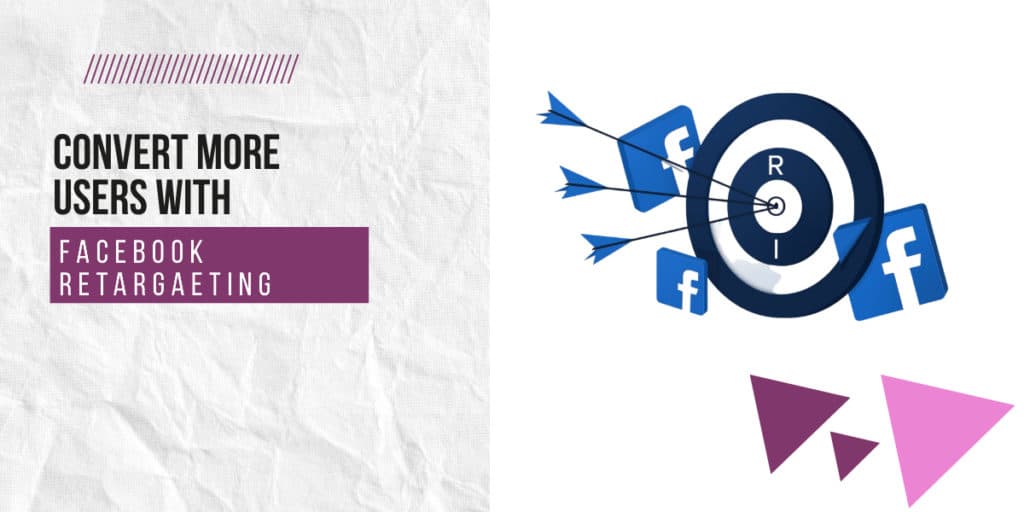Here’s the harsh truth. You can acquire thousands of free users each day, but if you don’t know how to get them to adopt your product and make them addicted to it, they won’t stick around.
User adoption of your product can be executed in a couple of different ways, through different channels like:
- Inside the product itself
- On external platforms, like Facebook
In this post, we are going to learn:
- The essential pillars of user adoption of your product
- How to segment your customer base
- How to unleash the “aha!” moment of your product through Facebook
- How to activate your trial users on Facebook
- Different post-payment feature adoption strategies you can use on Facebook
Ready?
What is user adoption and why is it important?
User adoption is the process of making your trial or new customers addicted to your product. It essentially teaches them how to solve problems and make your product an essential part of their lives.
But you can’t do it with top of the funnel marketing or sales anymore. In this era of product-led growth, your product does all the talking.
Product-led growth (PLG) is the term used when your product is the primary driver of customer acquisition. This method also works on expansion, retention, churn and user/feature adoption. PLG has been recently popularized by freemium and free trial businesses, like Slack, Dropbox, Typeform, Trello, and others.
This is because at the end of the day, your customers stay because of the value they derive from your product, not necessarily because of your marketing efforts.
And they will only get the value if they adopt your value-driving features.
This is where user adoption flywheels come into play.
What are flywheels? A flywheel is basically any mechanism designed to boost the momentum of positive results over time, so you get better results with less effort.
The user adoption flywheel is designed to move the needle and motivate your customers to move further with your product.
The general idea of the user adoption flywheel is to turn your free and trial users into paying customers, and later into brand advocates.
This is an example of how your user adoption flywheel might look:

When it comes to the organization of user onboarding flywheel, we can see that there are some essential pillars:
- “Aha!” moment: This is the moment when your free/trial customers perceive the value of your product and its solution. In other words, they can imagine your product performing miracles.
- Activation: During Activation, your customers actually feel the value of your product. Unlike in the “aha!” stage, now your product has given particular value to them. At this point, they’re well engaged with your product.
- Paid customer: Once the customer has been activated, the next step is for them to purchase your product and start using it regularly.
- Advocate: The advocacy stage is ultimately where you want all of your customers to end up. These types of customers will always take the opportunity to speak out and praise your product.
Now when we know all of this, it’s pretty much easy to imagine some user adoption flywheel inside the product. Right?
But, how can you implement this on paid social and Facebook ads? And before all, why should you do that?
Why should brands think about paid social for user adoption?
Today, many SaaS businesses are using these two channels to onboard customers and accelerate the adoption of their product:
- In-app (such as creating interactive walkthroughs, checklists, customer engagement strategy boosters, and other methods)
- Transactional emails (sending triggered emails and educating their customers on the way)
But there are a couple of problems:
- Your product might be great and best on the market, but if it didn’t capture attention and unleashed that “aha!” moment in the first couple of minutes after someone signed-up, there’s a huge chance that people will leave your product and never come back again
- Some products are just not designed for every-day usage. So customers won’t be checking your product and in-app notification often.
When it comes to emails:
- Users usually subscribe to many newsletters and use many tools, and their inboxes are crowded with other emails like yours. It’s becoming even harder to capture attention in email inboxes.
And the biggest problem is, that most companies are not pushing for the second action. Once the customer just “declines” to do something, we do nothing. Actually, according to Userpilot’s state of product onboarding research, 17% of companies don’t retarget their users in any way.
When we think about all of these, capturing our user’s attention on platforms other than your product and email seems like a logical move.
And since everyone’s on Facebook, what’s a better way to do it then retargeting them through paid social there?
But, before we even start thinking about user adoption flywheel on Facebook, we must know how to segment our customers.
How to segment your SaaS customer base
User segmentation is one of the most important things when it comes to successfully retargeting your new customers on paid social channels like Facebook.
Why is that?
Segmentation allows us to:
- Target our customers better
- Show them the right messages on the right time
- Personalize the user adoption flywheel to them
- Better correspond with your marketing, sales and product departments
When it comes to the segmentation itself, there are a couple of ways we can do that.
The most basic one is segmenting your customers based on their stage in the user journey (the one we’ve seen above), so we have customers who are:
- just registered
- unleashed “aha!” moment
- activated
- paying
- power customers
- brand advocates
We can also segment our customers based on the particular features they activated and the workflows they did inside their product:
- customers who activated the most most important feature
- customers who are heavily using one feature, but don’t know for some other workflow that will make their life easier
- customers who activated only the most basic features
Of course, there’s also demographic segmentation:
- segmentation by company size
- segmentation by deal size (paying plans)
- segmentation by the account’s title and job description and so on.
Customer data platforms, like Hull, can easily collect those types of information, store it in particular databases, and make it accessible by all departments inside your company, making it easy for you to do your customer segmentation.
To highlight the importance of segmentation, let’s see how a project management tool, monday.com is using it to drive its customer acquisition.
Once you start reading monday.com’s blog posts, it collects data about you and your interests. Later, it uses a Facebook pixel to retarget you on Facebook with offers you can’t resist.
For example, if you read content on their website about recruitment, you might see Facebook ads like these:
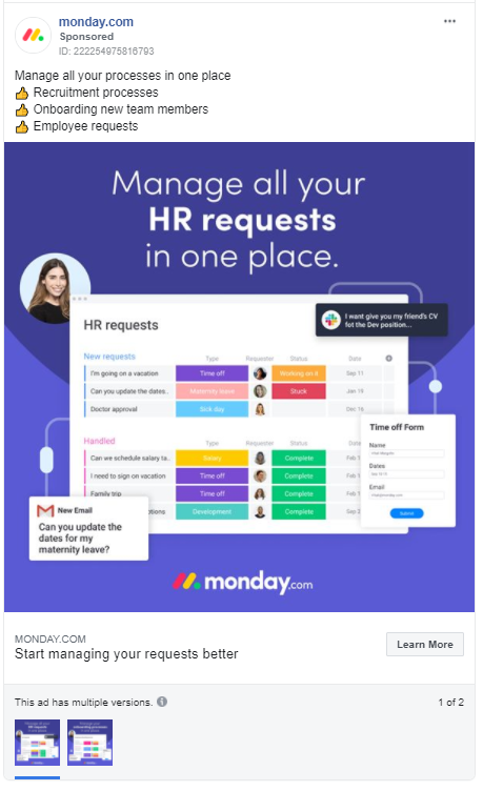
If you read content about onboarding new team members, you will see an ad like this:
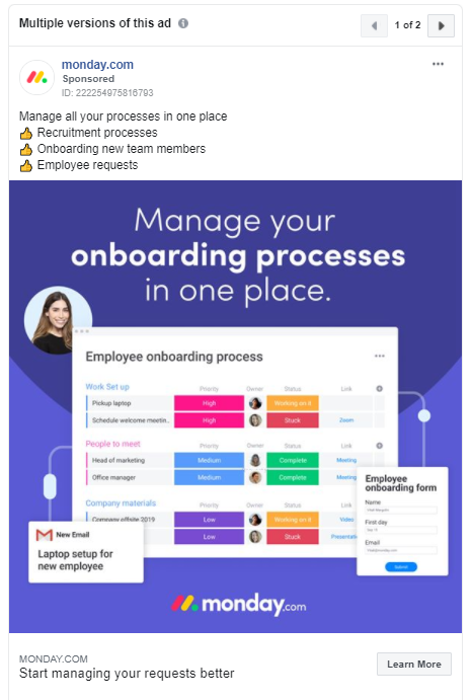
Also, great segmentation doesn’t just allow monday.com to target you with different content types. It allows them to target specific client profiles.
But what happens if you work in some particular industry? Monday.com shows you ads that are personalized to you.
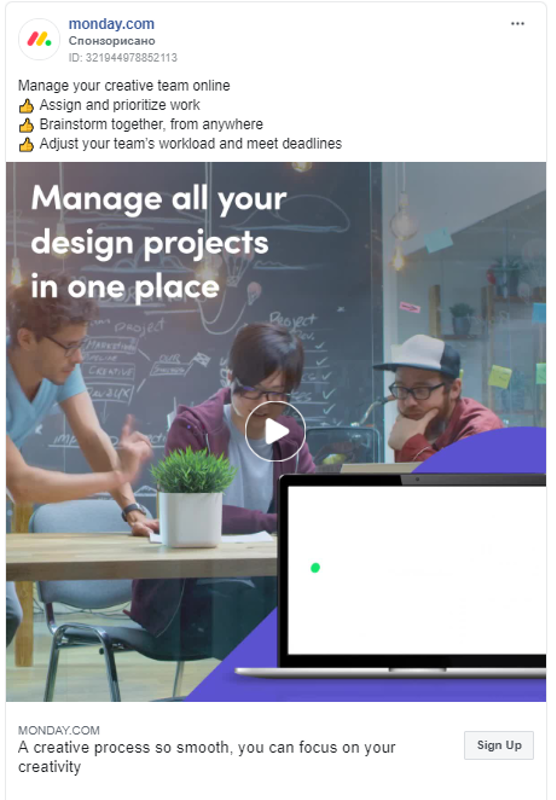
Even if you’re in the construction business, monday.com has you covered:
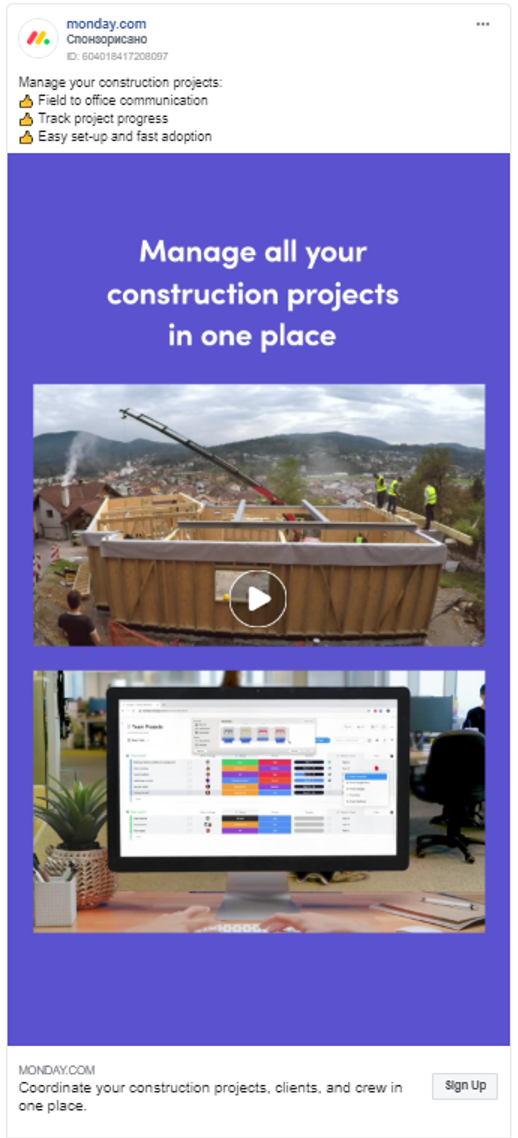
Not to mention that they also use segmentation to run multi-language campaigns targeting more people and creating more personalized campaigns at the same time.
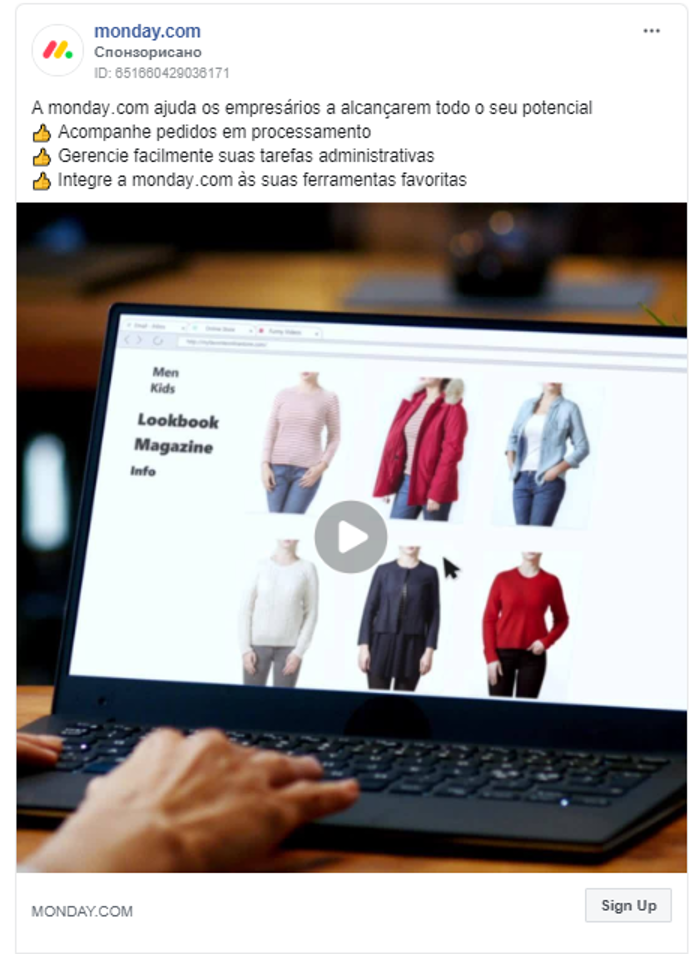
You can use some of the Smartly alternatives, tools that automate your design creative process (save you a ton of time), and help you create multiple ad designs on different languages in a fraction of time.
This is the power of user segmentation.
Now when we know why segmentation is important and how we can do it, it’s time to see some amazing user adoption flywheels on Facebook and other paid social channels.
How to unleash “aha!” moment through Facebook ads
Once you get your customers in the product, unleashing “aha!” moment is the first thing you should do (as quickly as possible), once someone signs up for your product.
But if in some cases, you don’t manage to do this inside your product, Facebook is the second-best channel where you can correct your mistakes.
Tidio, a live chat and chatbot platform is using Facebook ads to unleash the “aha!” moment.
Here’s how the ad looks like:
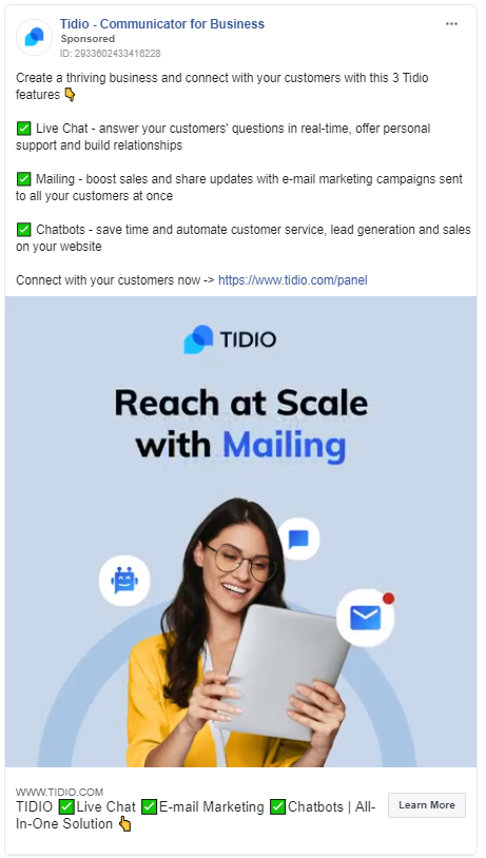
This ad is great because:
- It’s short, crisp, catchy and straight-to-the-point
- It’s frictionless since it leads people straight to their Tidio account to test these options
On the other hand, we at Userpilot did one campaign back in April 2020 that allowed us to convert more trial customers and adopt them better.
Userpilot is a B2B product, and we realized that people shopping for B2B SaaS tools in “trial” phase are mainly testing products like ours and comparing them with other tools.
So we decided to create an ad that will win them back to our side:
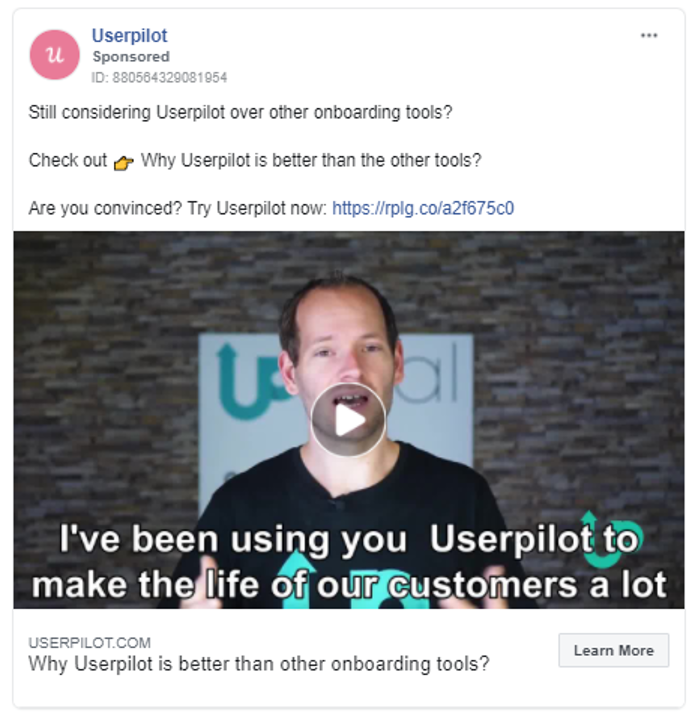
Combination of honesty and testimonial was a killer combination for us.
On the other hand, Better Proposals is using the combination of transactional emails and Facebook ads to recapture people who abandoned them during the trial.
Upon signing up, each person leaves their email address which helps them reach out during the trial period and afterwards.
When it comes to those who haven’t chosen a plan after their 14-day free trial, Intercom automatically adds them into a Trial Recovery campaign which pushes more than 20 emails throughout several months.
These transactional emails cover several areas, from educating businesses on how to boost their sales, to emphasizing the most important benefits of proposal software.
At the same time, Facebook will use Pixel to create ads and retarget people who visited their website in the last 90 days.
This strategy allows them to bring a decent amount of trial customers back and later convert them into paying customers.
How to use Facebook ads to adopt users on some particular features?
Once the customer unleashed the “aha!” moment, it’s time to adopt it to other features and eventually activate him and convert into a paying customer.
Not all customers will crack into your product from the beginning. Some of them will need a little bit more education and motivation to learn new things and adapt other features.
That’s the reason why you need to use some of the product marketing strategies to accomplish this.
Certainly, one of them is using Facebook ads.
Let’s go back to Tidio. Besides using Facebook ads to unleash the “aha!” moment, Tidio is also adopting their customers on some particular features through Facebook ads.
Here’s how one of their feature adoption ads looks like:
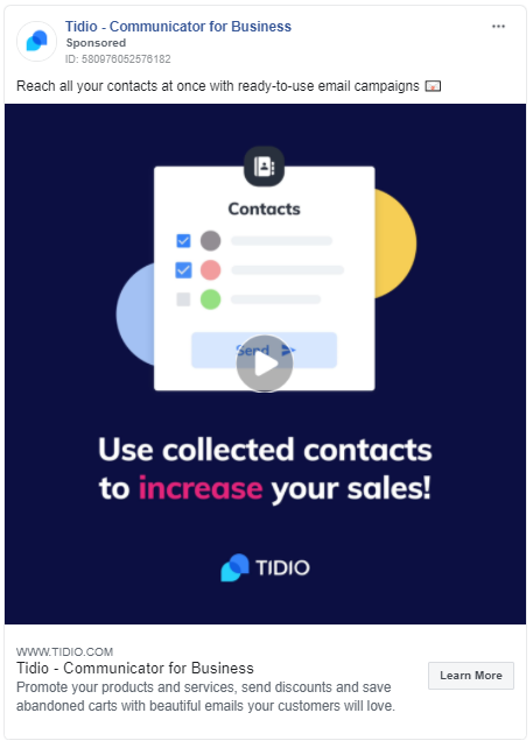
You can also use Facebook ads to “educate” your customers and adapt them on some “workflows” that will make their entire experience with your product more amazing and easier.
Again, Tidio does this as well.
If you’re using Tidio to send email marketing campaigns, but not using their email templates feature, they will try to encourage adoption of that feature, so you can eventually make your entire workflow quicker:
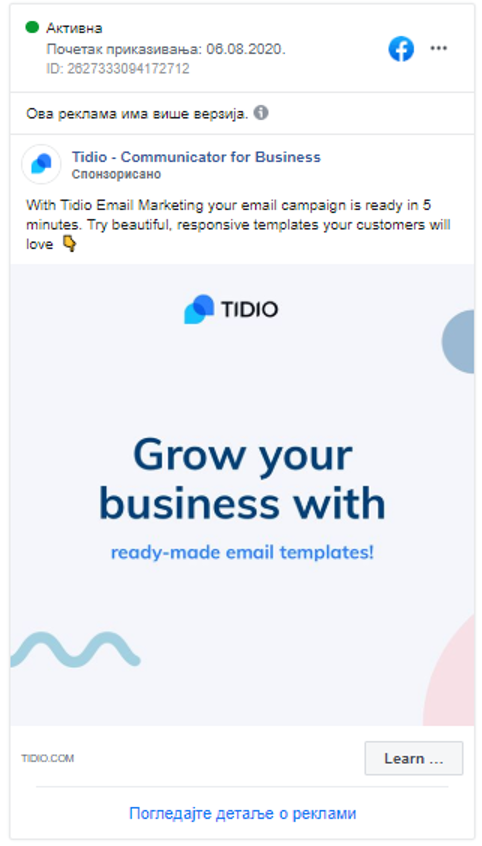
The bottom line
As you can see, user adoption flywheel is an essential part of every growing product.
But just having it isn’t enough. We need to:
- Segment our users
- Show the right experiences at the right time to our customers depending on their stage of the customer journey
- Use the omnichannel approach to engage with them
Very often, people will miss in-app notifications or emails – so social media platforms are the perfect way to capture their attention and win them back. You can also use them in combination with other methods, just as Betterproposals is using the combination of transactional emails and Facebook ads to recapture people who abandoned them during the trial.
The right segmentation and the right experiences with the combination of the omnichannel approach make a killer strategy of adopting your customers. It’s your loss if you don’t test it out.

